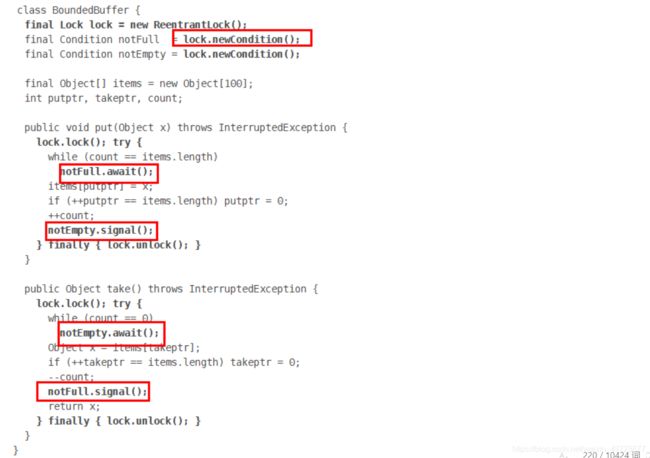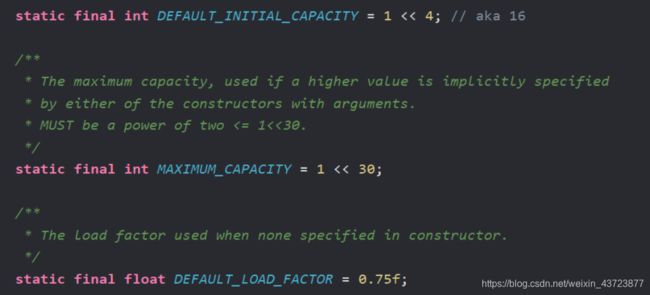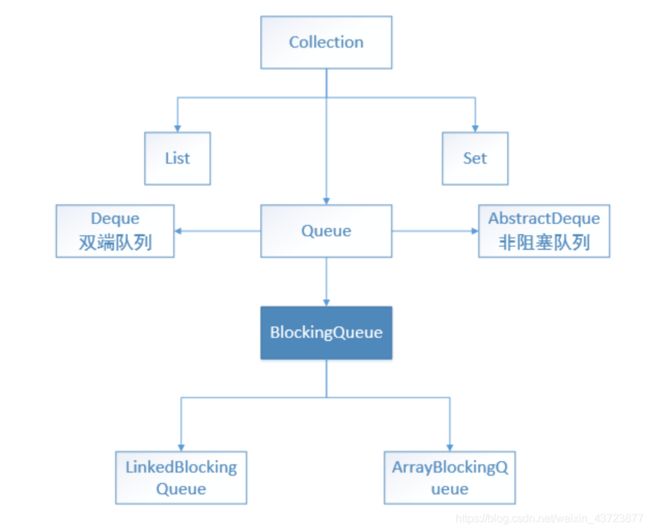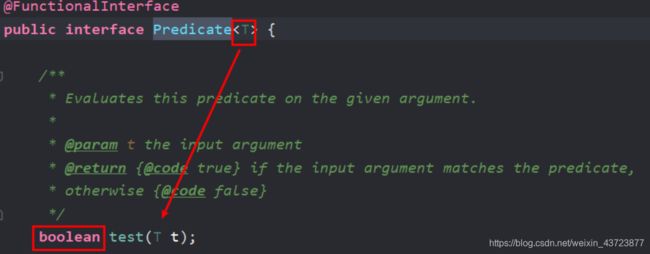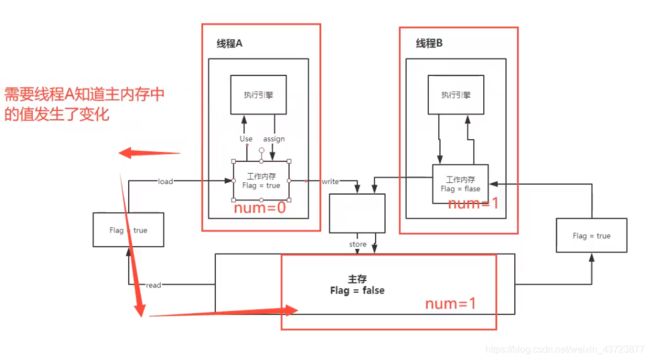JUC并发编程学习笔记
目录
- 前言
- 一、简介
-
- 1、什么是JUC
- 二、线程和进程
- 三、Lock锁(重点)
- 四、生产者和消费者问题
- 五、8锁现象
- 六、集合类不安全
- 七、Callable(简单)
- 八、常用的辅助类
-
- 8.1 CountDownLatch
- 8.2 CyclicBarrier
- 8.3 SemaPhore
- 九、读写锁
- 十、阻塞队列
- 十一、线程池(重点)
- 十二、四大函数式接口(必须掌握)
- 十三、流式计算
- 十四、ForkJoin
- 十五、异步回调
- 十六、JMM
- 十七、Volatile
- 十八、彻底玩转单例模式
- 十九、深入理解CAS
- 二十、原子引用
- 二十一、各种锁的理解
-
- 21.1 公平锁
- 21.2 可重入锁
- 21.3 自旋锁
- 21.4 死锁
前言
看狂神JUC并发编程的学习笔记
一、简介
1、什么是JUC
Java 5.0 提供了java.util.concurrent(简称JUC)包,在此包中增加了在并发编程中很常用的使用工具类,用于定义类似于线程的自定义子系统,包括线程池、异步IO和轻量级任务框架。提供可调的、灵活的线程池。还提供了设计用于多线程上下文中的Collection实现等。
二、线程和进程
线程和进程
进程:例如:一个程序,QQ.exe,Music.exe 程序的集合;
线程:例如:开了一个Typora进程,里面有写字、自动保存等线程
一个进程往往可以包含多个线程,至少包含一个!
Java默认有几个线程? 2 个 mian、GC
开启线程的方式:Thread、Runnable、Callable
Java真的可以开启线程吗 不可以!只能通过本地方法调用底层的c++,Java是无法直接操作硬件的。
public synchronized void start() {
/**
* This method is not invoked for the main method thread or "system"
* group threads created/set up by the VM. Any new functionality added
* to this method in the future may have to also be added to the VM.
*
* A zero status value corresponds to state "NEW".
*/
if (threadStatus != 0)
throw new IllegalThreadStateException();
/* Notify the group that this thread is about to be started
* so that it can be added to the group's list of threads
* and the group's unstarted count can be decremented. */
group.add(this);
boolean started = false;
try {
start0();
started = true;
} finally {
try {
if (!started) {
group.threadStartFailed(this);
}
} catch (Throwable ignore) {
/* do nothing. If start0 threw a Throwable then
it will be passed up the call stack */
}
}
}
//本地方法,底层的C++,Java无法直接操作硬件
private native void start0();
并发、并行
并发编程:并发、并行
并发:多线程操作同一个资源;
- CPU一核,模拟出来多线程。快速交替。
并行:多个人一起行走
- CPU多核,多个线程可以同时执行;线程池
获取CPU的核数:
package com.radish.demo01;
/**
* @author: Radish
* @date: 2020-10-28 11:18
*/
public class Test1 {
public static void main(String[] args) {
//获取CPU的核数
//CPU密集型,IO密集型
System.out.println(Runtime.getRuntime().availableProcessors());
}
}
并发编程的本质:充分利用CPU的资源
线程有几个状态
public enum State {
// 新生
NEW,
// 运行
RUNNABLE,
// 阻塞
BLOCKED,
// 等待,死死地等
WAITING,
// 超时等待
TIMED_WAITING,
// 终止
TERMINATED;
}
wait/sleep 区别
1、来自不同的类
wait=>Object
sleep=>Thread
2、关于锁的释放
wait会释放锁,sleep睡觉了,抱着锁睡觉,不会释放
3、使用范围不同
wait :必须在同步代码块中
sleep:可以在任何地方睡
X 4、是否需要捕获异常
wait 不需要捕获异常
sleep 必须要捕获异常
三、Lock锁(重点)
传统 Synchronized
package com.radish.demo01;
/**
* @author: Radish
* @date: 2020-10-28 11:41
*/
//基本的卖票例子
/**
* 真正的多线程开发,公司中的开发,降低耦合性
* 线程就是一个单独的资源类,没有任何附属的操作
* 1、属性、方法
*
*/
public class SaleTicketDemo01 {
public static void main(String[] args) {
// 并发:多线程操作同一个资源类
Ticket ticket = new Ticket();
//@FunctionalInterface 函数式接口,jdk1.8 lambda表达式(参数)->{代码}
new Thread(() -> {
for (int i = 0; i < 60; i++) {
ticket.sale();
}
}, "A").start();
new Thread(() -> {
for (int i = 0; i < 60; i++) {
ticket.sale();
}
}, "B").start();
new Thread(() -> {
for (int i = 0; i < 60; i++) {
ticket.sale();
}
}, "C").start();
}
}
// 资源类 OOP
class Ticket{
// 属性、方法
private int number = 50;
//卖票的方式
//synchronized 本质:队列,锁
public synchronized void sale(){
if(number > 0){
System.out.println(Thread.currentThread().getName()+"卖出了"+(number--)+"票,剩余"+number);
}
}
}
Lock接口
公平锁:十分公平,先来后到
非公平锁:十分不公平:可以插队(默认)
package com.radish.demo01;
/**
* @author: Radish
* @date: 2020-10-28 11:41
*/
//基本的卖票例子
import java.util.concurrent.locks.Lock;
import java.util.concurrent.locks.ReentrantLock;
/**
* 真正的多线程开发,公司中的开发,降低耦合性
* 线程就是一个单独的资源类,没有任何附属的操作
* 1、属性、方法
*/
public class SaleTicketDemo02 {
public static void main(String[] args) {
// 并发:多线程操作同一个资源类
Ticket2 ticket = new Ticket2();
//@FunctionalInterface 函数式接口,jdk1.8 lambda表达式(参数)->{代码}
new Thread(() -> { for (int i = 0; i < 40; i++) ticket.sale(); }, "A").start();
new Thread(() -> { for (int i = 0; i < 40; i++) ticket.sale(); }, "B").start();
new Thread(() -> { for (int i = 0; i < 40; i++) ticket.sale(); }, "C").start();
}
}
// Lock三部曲:
// 1、new ReentrantLock();
// 2、lock.lock(); //加锁
// 3、finally=> lock.unlock(); //解锁
class Ticket2{
// 属性、方法
private int number = 50;
Lock lock = new ReentrantLock();
//卖票的方式
//synchronized 本质:队列,锁
public void sale(){
lock.lock(); // 加锁
try {
//业务代码
if(number > 0){
System.out.println(Thread.currentThread().getName()+"卖出了"+(number--)+"票,剩余"+number);
}
}catch (Exception e){
}finally {
lock.unlock(); // 解锁
}
}
//对象
//class
}
Synchronized和Lock区别
- Synchronized 内置的java关键字,Lock是一个Java类
- Synchronized 无法判断获取锁的状态,Lock 可以判断会否获取到了锁
- Synchronized 会自动释放锁,lock必须要手动解锁!如果不释放锁,死锁
- Synchronized 线程1(获得锁,阻塞)、线程2(等待,傻傻的等);Lock锁就不一定会等待下去;
- Synchronized 可重入锁,不可以中断的,非公平;Lock,可重入锁,可以 判断锁,非公平(可以自己设置);
- Synchronized 适合锁少量的代码同步问题,Lock 适合锁大量的同步代码!
锁是什么,如何判断锁的是谁!
四、生产者和消费者问题
生产者和消费者问题 Synchronized版
package com.radish.pc;
/**
* @author: Radish
* @date: 2020-10-28 13:09
* 线程之间的通信问题:生产者和消费者问题 等待唤醒,通知唤醒
* 线程交替执行 A B 操作同一个变量 num=0
* A num+1
* B num-1
*/
public class A {
public static void main(String[] args) {
Data data = new Data();
new Thread(()->{
for (int i = 0; i < 10; i++) {
try {
data.increment();
} catch (InterruptedException e) {
e.printStackTrace();
}
}
},"A").start();
new Thread(()->{
for (int i = 0; i < 10; i++) {
try {
data.decrement();
} catch (InterruptedException e) {
e.printStackTrace();
}
}
},"B").start();
}
}
// 判断等待,业务,通知
class Data{//数字 资源类
private int number = 5;
//+1
public synchronized void increment() throws InterruptedException {
if (number != 0) {
// 等待
this.wait();
}
number++;
System.out.println(Thread.currentThread().getName()+"=>"+number);
// 通知其他线程,我+1完毕了
this.notifyAll();
}
//-1
public synchronized void decrement() throws InterruptedException {
if (number == 0) {
// 等待
this.wait();
}
number--;
System.out.println(Thread.currentThread().getName()+"=>"+number);
// 通知其他线程,我-1完毕了
this.notifyAll();
}
}
问题存在:A,B,C,D 4个线程!虚假唤醒
if 改为 while
生产者和消费者问题 JUC版
package com.radish.pc;
import java.util.concurrent.locks.Condition;
import java.util.concurrent.locks.Lock;
import java.util.concurrent.locks.ReentrantLock;
/**
* @author: Radish
* @date: 2020-10-28 13:42
*/
public class B {
public static void main(String[] args) {
Data2 data = new Data2();
new Thread(()->{
for (int i = 0; i < 10; i++) {
try {
data.increment();
} catch (InterruptedException e) {
e.printStackTrace();
}
}
},"A").start();
new Thread(()->{
for (int i = 0; i < 10; i++) {
try {
data.decrement();
} catch (InterruptedException e) {
e.printStackTrace();
}
}
},"B").start();
new Thread(()->{
for (int i = 0; i < 10; i++) {
try {
data.increment();
} catch (InterruptedException e) {
e.printStackTrace();
}
}
},"C").start();
new Thread(()->{
for (int i = 0; i < 10; i++) {
try {
data.decrement();
} catch (InterruptedException e) {
e.printStackTrace();
}
}
},"D").start();
}
}
// 判断等待,业务,通知
class Data2{//数字 资源类
private int number = 0;
Lock lock = new ReentrantLock();
Condition condition = lock.newCondition();
//condition.await(); // 等待
//condition.signalAll(); // 唤醒全部
//+1
public void increment() throws InterruptedException {
lock.lock();
try {
//业务代码
while (number != 0) {
// 等待
condition.await();
}
number++;
System.out.println(Thread.currentThread().getName()+"=>"+number);
// 通知其他线程,我+1完毕了
condition.signalAll();
}catch (Exception e) {
e.printStackTrace();
}finally {
lock.unlock();
}
}
//-1
public void decrement() throws InterruptedException {
lock.lock();
try {
while (number == 0) {
// 等待
condition.await();
}
number--;
System.out.println(Thread.currentThread().getName()+"=>"+number);
// 通知其他线程,我-1完毕了
condition.signalAll();
} catch (Exception e) {
e.printStackTrace();
} finally {
lock.unlock();
}
}
}
任何一个新技术,绝对不是仅仅只是覆盖原来的技术,优势或补充!
Condition 精准通知和唤醒线程
package com.radish.pc;
import java.util.concurrent.locks.Condition;
import java.util.concurrent.locks.Lock;
import java.util.concurrent.locks.ReentrantLock;
/**
* @author: Radish
* @date: 2020-10-28 14:00
* A执行完调用B B执行完调用C C执行完调用A
*/
public class C {
public static void main(String[] args) {
Data3 data3 = new Data3();
new Thread(()->{
for (int i = 0; i < 10; i++) {
data3.printA();
}
},"A").start();
new Thread(()->{
for (int i = 0; i < 10; i++) {
data3.printB();
}
},"B").start();
new Thread(()->{
for (int i = 0; i < 10; i++) {
data3.printC();
}
},"C").start();
}
}
class Data3{ //资源类 lock
private Lock lock = new ReentrantLock();
private Condition condition1 = lock.newCondition();
private Condition condition2 = lock.newCondition();
private Condition condition3 = lock.newCondition();
private int number = 1;
public void printA(){
lock.lock();
try {
//业务代码 判断-> 执行-> 通知
while (number != 1){
//等待
condition1.await();
}
System.out.println(Thread.currentThread().getName()+"=>AAAAA");
// 唤醒指定的人:B
number = 2;
condition2.signal();
} catch (Exception e) {
e.printStackTrace();
} finally {
lock.unlock();
}
};
public void printB(){
lock.lock();
try {
//业务代码 判断-> 执行-> 通知
while (number != 2){
condition2.await();
}
System.out.println(Thread.currentThread().getName()+"=>BBBBB");
number = 3;
condition3.signal();
} catch (Exception e) {
e.printStackTrace();
} finally {
lock.unlock();
}
};
public void printC(){lock.lock();
try {
//业务代码 判断-> 执行-> 通知
while (number != 3){
condition3.await();
}
System.out.println(Thread.currentThread().getName()+"=>CCCCC");
number = 1;
condition1.signal();
} catch (Exception e) {
e.printStackTrace();
} finally {
lock.unlock();
}
};
}
五、8锁现象
如何判断锁的是谁!永远的知道什么锁,锁到底锁的是谁!
深刻理解我们的锁
package com.radish.lock8;
import java.util.concurrent.TimeUnit;
/**
* @author: Radish
* @date: 2020-10-30 9:08
* 8锁,就是关于锁的8个问题
* 1、标准情况下,两个线程先打印 发短信还是打电话? 1/发短信 2/打电话
* 2、sendSms延迟4秒,两个线程先打印 发短信还是打电话? 1/发短信 2/打电话
*/
public class Test1 {
public static void main(String[] args) {
Phone phone = new Phone();
new Thread(()->{
phone.sendSms();
},"A").start();
try {
TimeUnit.SECONDS.sleep(1);
} catch (InterruptedException e) {
e.printStackTrace();
}
new Thread(()->{
phone.call();
},"B").start();
}
}
class Phone {
// synchronized 锁的对象是方法的调用者
// 两个方法用的是同一个锁,谁先拿到谁执行
public synchronized void sendSms(){
try {
TimeUnit.SECONDS.sleep(4);
} catch (InterruptedException e) {
e.printStackTrace();
}
System.out.println("发短信");
}
public synchronized void call(){
System.out.println("打电话");
}
}
package com.radish.lock8;
import java.util.concurrent.TimeUnit;
/**
* @author: Radish
* @date: 2020-10-30 9:08
* 3、增加了一个hello普通方法,先执行发短信还是hello 普通方法
* 4、两个对象,两个同步方法 发短信还是打电话 打电话 (对象不同)
*/
public class Test2 {
public static void main(String[] args) {
//两个对象
Phone2 phone1 = new Phone2();
Phone2 phone2 = new Phone2();
new Thread(()->{
phone1.sendSms();
},"A").start();
try {
TimeUnit.SECONDS.sleep(1);
} catch (InterruptedException e) {
e.printStackTrace();
}
new Thread(()->{
phone2.call();
},"B").start();
}
}
class Phone2 {
// synchronized 锁的对象是方法的调用者
// 两个方法用的是同一个锁,谁先拿到谁执行
public synchronized void sendSms(){
try {
TimeUnit.SECONDS.sleep(4);
} catch (InterruptedException e) {
e.printStackTrace();
}
System.out.println("发短信");
}
public synchronized void call(){
System.out.println("打电话");
}
// 这里没有锁!不是同步方法,不受锁的影响
public void hello(){
System.out.println("hello");
}
}
package com.radish.lock8;
import java.util.concurrent.TimeUnit;
/**
* @author: Radish
* @date: 2020-10-30 9:08
* 5、增加两个静态的同步方法,只有一个对象 发短信还是打电话先? 发短信
* 6、两个对象! 增加两个静态的同步方法,只有一个对象 发短信还是打电话先? 发短信
*/
public class Test3 {
public static void main(String[] args) {
//两个对象
Phone3 phone1 = new Phone3();
Phone3 phone2 = new Phone3();
new Thread(()->{
phone1.sendSms();
},"A").start();
try {
TimeUnit.SECONDS.sleep(1);
} catch (InterruptedException e) {
e.printStackTrace();
}
new Thread(()->{
phone2.call();
},"B").start();
}
}
//Phone3唯一的一个class对象
class Phone3 {
// synchronized 锁的对象是方法的调用者
// static 静态方法
// 类一加载就有了! 锁的是Class
public static synchronized void sendSms(){
try {
TimeUnit.SECONDS.sleep(4);
} catch (InterruptedException e) {
e.printStackTrace();
}
System.out.println("发短信");
}
public static synchronized void call(){
System.out.println("打电话");
}
}
package com.radish.lock8;
import java.util.concurrent.TimeUnit;
/**
* @author: Radish
* @date: 2020-10-30 9:08
* 7、1个静态同步方法,1个普通同步方法,一个对象。 先打印发短信还是打电话 打电话!
* 8、1个静态同步方法,1个普通同步方法,两个对象。 先打印发短信还是打电话 打电话!
*/
public class Test4 {
public static void main(String[] args) {
//两个对象
Phone4 phone1 = new Phone4();
Phone4 phone2 = new Phone4();
new Thread(()->{
phone1.sendSms();
},"A").start();
try {
TimeUnit.SECONDS.sleep(1);
} catch (InterruptedException e) {
e.printStackTrace();
}
new Thread(()->{
phone2.call();
},"B").start();
}
}
//Phone3唯一的一个class对象
class Phone4 {
// 静态的同步方法 锁的是Class类模板
public static synchronized void sendSms(){
try {
TimeUnit.SECONDS.sleep(4);
} catch (InterruptedException e) {
e.printStackTrace();
}
System.out.println("发短信");
}
// 普通的同步方法 锁的是调用者
public synchronized void call(){
System.out.println("打电话");
}
}
小结
new this 具体的一个手机
static Class 唯一的一个模板
六、集合类不安全
List不安全
package com.radish.unsafe;
import java.util.*;
import java.util.concurrent.CopyOnWriteArrayList;
/**
* @author: Radish
* @date: 2020-10-30 9:43
*/
//java.util.ConcurrentModificationException 并发修改异常!
public class ListTest {
public static void main(String[] args) {
// 并发下ArrayList不安全
/**
* 解决方案:
* 1、List
// CopyOnWrite 写入时复制 COW 计算机程序设计领域的一种优化策略
// 多个线程调用的时候,list,读取的时候是固定的,写入(覆盖)
// 在写入的时候避免覆盖,造成数据问题
// 读写分离
// CopyOnWriteArrayList 比 Vector 牛逼在哪里
// CopyOnWriteArrayList的方法用lock锁,而Vector用synchronized
List<Object> list = new CopyOnWriteArrayList<>();
for (int i = 0; i < 1000; i++) {
new Thread(()->{
list.add(UUID.randomUUID().toString().substring(0,5));
System.out.println(list);
},String.valueOf(i+1)).start();
}
}
}
Set 不安全
package com.radish.unsafe;
import java.util.Collections;
import java.util.HashSet;
import java.util.Set;
import java.util.UUID;
import java.util.concurrent.CopyOnWriteArraySet;
/**
* @author: Radish
* @date: 2020-10-30 10:06
* 同理可证 ConcurrentModificationException
* 1、Set set = Collections.synchronizedSet(new HashSet<>());
* 2、Set set = new CopyOnWriteArraySet<>();
*/
public class SetTest {
public static void main(String[] args) {
// Set set = Collections.synchronizedSet(new HashSet<>());
Set<Object> set = new CopyOnWriteArraySet<>();
for (int i = 0; i < 30; i++) {
new Thread(()->{
set.add(UUID.randomUUID().toString().substring(0,5));
System.out.println(set);
},String.valueOf(i)).start();
}
}
}
hashSet 底层是什么?
public HashSet() {
map = new HashMap<>();
}
//add set 本质就是 map key是无法重复的!
public boolean add(E e) {
return map.put(e, PRESENT)==null;
}
private static final Object PRESENT = new Object(); // 不变的值
IO、集合类、常用类
HashMap 不安全
package com.radish.unsafe;
import java.util.HashMap;
import java.util.Map;
import java.util.UUID;
import java.util.concurrent.ConcurrentHashMap;
/**
* @author: Radish
* @date: 2020-10-30 10:18
*
*/
public class MapTest {
public static void main(String[] args) {
// map是这样用的吗? 不是,工作中不用 HashMap
// 默认等价于什么? new HashMap<>(16, 0.75);
// Map map = new HashMap<>();
Map<String, Object> map = new ConcurrentHashMap<>();
for (int i = 0; i < 30; i++) {
new Thread(()->{
map.put(Thread.currentThread().getName(), UUID.randomUUID().toString().substring(0,5));
System.out.println(map);
},String.valueOf(i+1)).start();
}
}
}
七、Callable(简单)
1、可以有返回值
2、可以抛出异常
3、方法不同,run()/call()
代码测试
package com.radish.callable;
import java.util.concurrent.Callable;
import java.util.concurrent.ExecutionException;
import java.util.concurrent.FutureTask;
/**
* @author: Radish
* @date: 2020-10-30 10:57
*/
public class CallableTest {
public static void main(String[] args) throws ExecutionException, InterruptedException {
// new Thread(new Runnable()).start();
// new Thread(new FutureTask()).start();
// new Thread(new FutureTask(Callable)).start();
new Thread().start(); //怎么启动callable
MyThread myThread = new MyThread();
FutureTask futureTask = new FutureTask(myThread);
//适配类
new Thread(futureTask, "A").start();
new Thread(futureTask, "B").start(); //结果会被缓存,效率高 会打印1个call
Integer o = (Integer) futureTask.get(); // 这个get方法可能会产生阻塞!把它放到最后
System.out.println(o);
}
}
class MyThread implements Callable<Integer> {
@Override
public Integer call() throws Exception {
System.out.println("call()");
//耗时的操作
return 1024;
}
}
细节:
1、有缓存
2、结果可能需要等待,会阻塞!
八、常用的辅助类
8.1 CountDownLatch
package com.radish.add;
import java.util.concurrent.CountDownLatch;
/**
* @author: Radish
* @date: 2020-10-30 11:26
*/
public class CountDownLatchDemo {
public static void main(String[] args) throws InterruptedException {
// 总数是6 必须要执行任务的时候,再使用
CountDownLatch countDownLatch = new CountDownLatch(6);
for (int i = 0; i < 6; i++) {
new Thread(()->{
System.out.println(Thread.currentThread().getName()+"Go out");
countDownLatch.countDown();
},String.valueOf(i)).start();
}
countDownLatch.await(); //等待计数器归零,然后再向下执行
System.out.println("Close door");
}
}
原理:
countDownLatch.countDown(); //数量-1
countDownLatch.await(); //等待计数器归零,然后再向下执行
每次有线程调用countDown()数量-1,假设计数器变为0,countDownLatch.await() 就会被唤醒,继续执行!
8.2 CyclicBarrier
package com.radish.add;
import java.util.concurrent.BrokenBarrierException;
import java.util.concurrent.CyclicBarrier;
/**
* @author: Radish
* @date: 2020-10-30 11:39
*/
public class CycliBarrierDemo {
public static void main(String[] args) {
/**
* 集齐7颗龙珠召唤神龙
*/
//召唤龙珠的线程
CyclicBarrier cyclicBarrier = new CyclicBarrier(7, ()->{
System.out.println("召唤神龙成功");
});
for (int i = 0; i < 7; i++) {
final int temp = i;
// lambda能操作到 i 吗
new Thread(()->{
System.out.println(Thread.currentThread().getName()+"收集了"+(temp+1)+"星龙珠");
try {
cyclicBarrier.await(); //等待
} catch (InterruptedException e) {
e.printStackTrace();
} catch (BrokenBarrierException e) {
e.printStackTrace();
}
}).start();
}
}
}
8.3 SemaPhore
semaphore 信号量
package com.radish.add;
import java.util.concurrent.Semaphore;
import java.util.concurrent.TimeUnit;
/**
* @author: Radish
* @date: 2020-10-30 11:45
*/
public class SemaPhoreDemo {
public static void main(String[] args) {
// 线程数量:停车位
Semaphore semaphore = new Semaphore(3);
for (int i = 0; i < 6; i++) {
new Thread(()->{
// acquire 得到
try {
semaphore.acquire();
System.out.println(Thread.currentThread().getName()+"抢到车位");
TimeUnit.SECONDS.sleep(2);
System.out.println(Thread.currentThread().getName()+"离开车位");
} catch (InterruptedException e) {
e.printStackTrace();
} finally {
semaphore.release();// release 释放
}
},String.valueOf(i+1)).start();
}
}
}
semaphore.acquire(); 获得,假设如果已经满了,等待,等待被释放为止!
semaphore.release();释放,会将当前的信号量释放+1,然后唤醒等待的线程!
作用:多个共享资源互斥的使用!并发限流,控制最大的线程数!
九、读写锁
package com.radish.rw;
import java.util.HashMap;
import java.util.Map;
import java.util.concurrent.locks.ReadWriteLock;
import java.util.concurrent.locks.ReentrantReadWriteLock;
/**
* @author: Radish
* @date: 2020-10-30 16:59
* 独占锁(写锁) 一次只能被一个线程占有
* 共享锁(读锁) 多个线程可以同时占有
* ReadWriteLock
* 读-读 可以共存
* 读-写 不能共存
* 写-写 不能共存
*/
public class ReadWriteLockDemo {
public static void main(String[] args) {
MyCacheLock myCache = new MyCacheLock();
//写入
for (int i = 1; i <= 5; i++) {
final int temp = i;
new Thread(()->{
myCache.put(temp+"",temp+"");
},String.valueOf(i)).start();
}
//读取
for (int i = 1; i <= 5; i++) {
final int temp = i;
new Thread(()->{
myCache.get(temp+"");
},String.valueOf(i)).start();
}
}
}
/**
* 自定义缓存
*/
class MyCache{
private volatile Map<String,Object> map = new HashMap<>();
//存,写
public void put(String key, Object value){
System.out.println(Thread.currentThread().getName()+"写入"+key);
map.put(key, value);
System.out.println(Thread.currentThread().getName()+"写入OK"+key);
}
//取,读
public void get(String key){
System.out.println(Thread.currentThread().getName()+"读取"+key);
Object o = map.get(key);
System.out.println(Thread.currentThread().getName()+"读取OK"+key);
}
}
class MyCacheLock{
private volatile Map<String,Object> map = new HashMap<>();
// 读写锁:更加细粒度的控制
private ReadWriteLock readWriteLock = new ReentrantReadWriteLock();
//存,写入的时候,只希望同时只有一个线程写
public void put(String key, Object value){
readWriteLock.writeLock().lock();
try {
System.out.println(Thread.currentThread().getName()+"写入"+key);
map.put(key, value);
System.out.println(Thread.currentThread().getName()+"写入OK"+key);
} finally {
readWriteLock.writeLock().unlock();
}
}
//取,读,所有人都可以读!
public void get(String key){
readWriteLock.readLock().lock();
try {
System.out.println(Thread.currentThread().getName()+"读取"+key);
Object o = map.get(key);
System.out.println(Thread.currentThread().getName()+"读取OK"+key);
} finally {
readWriteLock.readLock().unlock();
}
}
}
十、阻塞队列
学会使用队列
添加、移除
四组API
| 方式 | 抛出异常 | 有返回值,不抛出异常 | 阻塞 等待 | 超时等待 |
|---|---|---|---|---|
| 添加 | add | offer() | pull() | offer(,) |
| 移除 | remove | poll() | take() | poll(,) |
| 检测队首元素 | element | peek | - | - |
package com.radish.bq;
import java.util.concurrent.ArrayBlockingQueue;
/**
* @author: Radish
* @date: 2020-10-30 18:52
*/
public class Test {
public static void main(String[] args) {
test1();
}
/**
* 抛出异常
*/
public static void test1(){
//队列大小
ArrayBlockingQueue blockingQueue = new ArrayBlockingQueue<>(3);
System.out.println(blockingQueue.add("a"));
System.out.println(blockingQueue.add("b"));
System.out.println(blockingQueue.add("c"));
//IllegalStateException: Queue full 抛出异常 队列已满
//System.out.println(blockingQueue.add("d"));
System.out.println(blockingQueue.remove());
System.out.println(blockingQueue.remove());
System.out.println(blockingQueue.remove());
//NoSuchElementException 抛出异常 没有元素
//System.out.println(blockingQueue.remove());
}
}
/**
* 有返回值,没有异常
*/
public static void test2(){
// 队列大小
ArrayBlockingQueue blockingQueue = new ArrayBlockingQueue<>(3);
System.out.println(blockingQueue.offer("a"));
System.out.println(blockingQueue.offer("b"));
System.out.println(blockingQueue.offer("c"));
//System.out.println(blockingQueue.offer("d")); //false 不抛出异常
System.out.println(blockingQueue.poll());
System.out.println(blockingQueue.poll());
System.out.println(blockingQueue.poll());
//System.out.println(blockingQueue.poll()); //null 不抛出异常
}
/**
* 等待、阻塞(一直阻塞)
*/
public static void test3() throws InterruptedException {
// 队列大小
ArrayBlockingQueue blockingQueue = new ArrayBlockingQueue<>(3);
blockingQueue.put("a");
blockingQueue.put("b");
blockingQueue.put("c");
//blockingQueue.put("d"); //队列没有位置了,一直阻塞
System.out.println(blockingQueue.take());
System.out.println(blockingQueue.take());
System.out.println(blockingQueue.take());
System.out.println(blockingQueue.take()); //没有这个元素 一直阻塞
}
SynchronousQueue 同步队列
没有容量,
进去一个元素,必须等待取出来之后,才能再往里面放一个元素!
put、take
package com.radish.bq;
import java.util.concurrent.SynchronousQueue;
import java.util.concurrent.TimeUnit;
/**
* @author: Radish
* @date: 2020-10-31 21:00
* 同步队列
* 和其他的BlockingQueue 不一样, SynchronousQueue 不存储元素
* put了一个元素,必须从里面先take取出来,否则不能在put进去
*/
public class SynchronousQueueDemo {
public static void main(String[] args) {
SynchronousQueue<String> synchronousQueue = new SynchronousQueue<>(); //同步队列
new Thread(()->{
try {
System.out.println(Thread.currentThread().getName()+"put 1");
synchronousQueue.put("1");
System.out.println(Thread.currentThread().getName()+"put 2");
synchronousQueue.put("2");
System.out.println(Thread.currentThread().getName()+"put 3");
synchronousQueue.put("3");
} catch (InterruptedException e) {
e.printStackTrace();
}
},"t1").start();
new Thread(()->{
try {
TimeUnit.SECONDS.sleep(3);
System.out.println(Thread.currentThread().getName()+"=>"+synchronousQueue.take());
TimeUnit.SECONDS.sleep(3);
System.out.println(Thread.currentThread().getName()+"=>"+synchronousQueue.take());
TimeUnit.SECONDS.sleep(3);
System.out.println(Thread.currentThread().getName()+"=>"+synchronousQueue.take());
} catch (InterruptedException e) {
e.printStackTrace();
}
},"t1").start();
}
}
十一、线程池(重点)
线程池:三大方法、7大参数、4种拒绝策略
池化技术
程序的运行,本质:占用系统的资源!优化资源的使用! => 池化技术
线程池、连接池、内存池、对象池… 创建和销毁。十分浪费资源。
池化技术:事先准备好一些资源,有人要用,就来我这里拿,用完之后还给我。
线程池的好处:
1、降低资源消耗
2、提高响应效率
3、方便管理
线程复用、可以控制最大并发数、管理线程
线程
package com.radish.pool;
import java.util.concurrent.ExecutorService;
import java.util.concurrent.Executors;
/**
* @author: Radish
* @date: 2020-10-31 21:43
*/
// Executors 工具类、3大方法
public class Demo01 {
public static void main(String[] args) {
// ExecutorService threadPool = Executors.newSingleThreadExecutor();//单个线程
// ExecutorService threadPool = Executors.newFixedThreadPool(5);// 创建一个固定的线程池的大小
ExecutorService threadPool = Executors.newCachedThreadPool();// 可伸缩的,遇强则强,遇弱则弱
try {
for (int i = 0; i < 10; i++) {
// 使用了线程池之后,要使用线程池创建线程
threadPool.execute(()->{
System.out.println(Thread.currentThread().getName()+" ok");
});
}
} catch (Exception e) {
e.printStackTrace();
} finally {
// 线程池用完,程序结束,关闭线程池
threadPool.shutdown();
}
}
}
七大参数
源码分析
public static ExecutorService newSingleThreadExecutor() {
return new FinalizableDelegatedExecutorService
(new ThreadPoolExecutor(1, 1,
0L, TimeUnit.MILLISECONDS,
new LinkedBlockingQueue<Runnable>()));
}
public static ExecutorService newFixedThreadPool(int nThreads) {
return new ThreadPoolExecutor(nThreads, nThreads,
0L, TimeUnit.MILLISECONDS,
new LinkedBlockingQueue<Runnable>());
}
public static ExecutorService newCachedThreadPool() {
return new ThreadPoolExecutor(0, Integer.MAX_VALUE,
60L, TimeUnit.SECONDS,
new SynchronousQueue<Runnable>());
}
//本质:ThreadPoolExecutor()
public ThreadPoolExecutor(int corePoolSize, // 核心线程池大小
int maximumPoolSize, // 最大核心线程池大小
long keepAliveTime, // 超时了没有人调用就会释放
TimeUnit unit, // 超时单位
BlockingQueue<Runnable> workQueue, // 阻塞队列
ThreadFactory threadFactory, // 线程工厂,创建线程的,一般不用动
RejectedExecutionHandler handler // 拒绝策略) {
if (corePoolSize < 0 ||
maximumPoolSize <= 0 ||
maximumPoolSize < corePoolSize ||
keepAliveTime < 0)
throw new IllegalArgumentException();
if (workQueue == null || threadFactory == null || handler == null)
throw new NullPointerException();
this.acc = System.getSecurityManager() == null ?
null :
AccessController.getContext();
this.corePoolSize = corePoolSize;
this.maximumPoolSize = maximumPoolSize;
this.workQueue = workQueue;
this.keepAliveTime = unit.toNanos(keepAliveTime);
this.threadFactory = threadFactory;
this.handler = handler;
}
手动创建一个线程池
package com.radish.pool;
import java.util.concurrent.*;
/**
* @author: Radish
* @date: 2020-10-31 21:43
*/
// Executors 工具类、3大方法
/**
* new ThreadPoolExecutor.AbortPolicy() // 银行满了,还有人进来,不处理这个人的,抛出异常
* new ThreadPoolExecutor.CallerRunsPolicy() // 哪来的去哪里
* new ThreadPoolExecutor.DiscardPolicy() // 队列满了,丢掉任务,不会抛出异常!
* new ThreadPoolExecutor.DiscardOldestPolicy() // 队列满了,尝试去和最早的竞争,也不会抛出异常
*/
public class Demo01 {
public static void main(String[] args) {
// ExecutorService threadPool = Executors.newSingleThreadExecutor();//单个线程
// ExecutorService threadPool = Executors.newFixedThreadPool(5);// 创建一个固定的线程池的大小
// ExecutorService threadPool = Executors.newCachedThreadPool();// 可伸缩的,遇强则强,遇弱则弱
// 自定义线程池! 工作中只会使用 ThreadPoolExecutor
ExecutorService threadPool = new ThreadPoolExecutor(
2,
5,
3,
TimeUnit.SECONDS,
new LinkedBlockingQueue<>(3),
Executors.defaultThreadFactory(),
new ThreadPoolExecutor.DiscardOldestPolicy() // 队列满了,尝试去和最早的竞争,也不会抛出异常
);
try {
// 最大承载:Deque+max
// 超过 RejectedExecutionException
for (int i = 1; i <= 9; i++) {
// 使用了线程池之后,要使用线程池创建线程
threadPool.execute(()->{
System.out.println(Thread.currentThread().getName()+" ok");
});
}
} catch (Exception e) {
e.printStackTrace();
} finally {
// 线程池用完,程序结束,关闭线程池
threadPool.shutdown();
}
}
}
4种拒绝策略
/**
* new ThreadPoolExecutor.AbortPolicy() // 银行满了,还有人进来,不处理这个人的,抛出异常
* new ThreadPoolExecutor.CallerRunsPolicy() // 哪来的去哪里
* new ThreadPoolExecutor.DiscardPolicy() // 队列满了,丢掉任务,不会抛出异常!
* new ThreadPoolExecutor.DiscardOldestPolicy() // 队列满了,尝试去和最早的竞争,也不会抛出异常
*/
小结和扩展
池的最大的大小如何去设置
了解:IO密集型,CPU密集型:(调优)
package com.radish.pool;
import java.util.concurrent.*;
/**
* @author: Radish
* @date: 2020-10-31 21:43
*/
public class Demo01 {
public static void main(String[] args) {
// 自定义线程池! 工作中只会使用 ThreadPoolExecutor
// 最大线程该如何定义
// 1、CPU密集型 几核,就定几,可以保持CPU的效率最高!
// 2、IO密集型 > 判断你程序中十分耗IO的线程,
// 程序 15个大型任务 io十分占用资源!
// 获取CPU的核数
System.out.println(Runtime.getRuntime().availableProcessors());
ExecutorService threadPool = new ThreadPoolExecutor(
2,
Runtime.getRuntime().availableProcessors(),
3,
TimeUnit.SECONDS,
new LinkedBlockingQueue<>(3),
Executors.defaultThreadFactory(),
new ThreadPoolExecutor.DiscardOldestPolicy() // 队列满了,尝试去和最早的竞争,也不会抛出异常
);
try {
// 最大承载:Deque+max
// 超过 RejectedExecutionException
for (int i = 1; i <= 9; i++) {
// 使用了线程池之后,要使用线程池创建线程
threadPool.execute(()->{
System.out.println(Thread.currentThread().getName()+" ok");
});
}
} catch (Exception e) {
e.printStackTrace();
} finally {
// 线程池用完,程序结束,关闭线程池
threadPool.shutdown();
}
}
}
十二、四大函数式接口(必须掌握)
函数式接口:只有一个方法的接口
Function函数式接口
@FunctionalInterface
public interface Runnable {
public abstract void run();
}
// 泛型、枚举、反射
// lambda表达式、链式编程、函数式接口、Stream流式计算
// 超级多FunctionalInterface
// 简化编程模型,在新版本的框架底层大量应用
// foreach(消费者类的函数式接口)
/**
* @author: Radish
* @date: 2020-11-01 0:36
* Function 函数型接口,有一个输入参数,有一个输出
* 只要是 函数型接口 可以 用lambda表达式简化
*/
public class Demo01 {
public static void main(String[] args) {
// Function function = new Function() {
// @Override
// public String apply(String s) {
// return s;
// }
// };
Function function = (s) -> {return s;};
System.out.println(function.apply("radish"));
}
}
断定型接口:有一个参数,返回值只能是布尔值!
/**
* @author: Radish
* @date: 2020-11-01 0:45
* 断定型接口:有一个输入参数,返回值只能是 布尔值!
*/
public class Demo02 {
public static void main(String[] args) {
// Predicate predicate = new Predicate() {
// @Override
// public boolean test(String s) {
// return s.isEmpty();
// }
// };
Predicate<String> predicate = (s)->{return s.isEmpty();};
System.out.println(predicate.test("123"));
}
}
Consumer:只有输入,没有返回值
/**
* @author: Radish
* @date: 2020-11-01 0:55
* Consumer 消费型接口:只有输入,没有返回值
*/
public class Demo03 {
public static void main(String[] args) {
// Consumer consumer = new Consumer() {
// @Override
// public void accept(String s) {
// System.out.println(s);
// }
// };
Consumer<String> consumer = s -> { System.out.println(s); };
consumer.accept("radish");
}
}
Supplier 供给型接口:没有参数,只有返回值
/**
* @author: Radish
* @date: 2020-11-01 0:58
* Supplier 供给型接口:没有参数,只有返回值
*/
public class Demo04 {
public static void main(String[] args) {
// Supplier supplier = new Supplier() {
// @Override
// public Integer get() {
// return 1024;
// }
// };
Supplier<Integer> supplier = ()->{return 1024;};
System.out.println(supplier.get());
}
}
十三、流式计算
什么是Stream流式计算
大数据:存储+计算
集合、MySQL本质就是用来存储东西的;
计算都应该交给流来操作!
十四、ForkJoin
什么是ForkJoin
ForkJoin在JDK1.7,并行执行任务!提供效率。大数据量!
ForkJoin特点:工作窃取
这个里面维护的是双端队列
ForkJoin 操作
package com.radish.forkjoin;
import java.util.concurrent.RecursiveTask;
/**
* @author: Radish
* @date: 2020-11-01 15:06
* 求和计算任务:
* 如何使用 forkjoin
* 1、forkjoinPool 通过它来执行
* 2、计算任务 forkjoinPool.execute(ForkJoinTask task)
* 3、计算列要继承 ForkJoinTask
*/
public class ForkJoinDemo extends RecursiveTask<Long> {
private Long start;
private Long end;
//临界值
private Long temp = 10000L;
public ForkJoinDemo(Long start, Long end){
this.start = start;
this.end = end;
}
//计算方法
@Override
protected Long compute() {
if (end -start < temp) {
Long sum = 0L;
for (Long i = start; i <= end; i++) {
sum += i;
}
return sum;
}else { //forkjoin 递归
long middle = (start + end) / 2; //中间值
ForkJoinDemo task1 = new ForkJoinDemo(start, middle);
task1.fork(); // 拆分任务,把任务压入线程队列
ForkJoinDemo task2 = new ForkJoinDemo(middle+1, end);
task2.fork(); // 拆分任务,把任务压入线程队列
return task1.join() + task2.join();
}
}
}
测试类
package com.radish.forkjoin;
import java.util.concurrent.ExecutionException;
import java.util.concurrent.ForkJoinPool;
import java.util.concurrent.ForkJoinTask;
import java.util.stream.LongStream;
/**
* @author: Radish
* @date: 2020-11-01 15:28
*/
public class Test {
public static void main(String[] args) throws ExecutionException, InterruptedException {
// test1(); //时间5960
// test2(); //时间9086
test3(); //时间766
}
//普通程序员
public static void test1(){
Long sum = 0L;
long start = System.currentTimeMillis();
for (int i = 1; i <= 10_0000_0000; i++) {
sum += i;
}
long end = System.currentTimeMillis();
System.out.println("sum="+sum+" 时间"+(end-start));
}
// 会使用ForkJoin
public static void test2() throws ExecutionException, InterruptedException {
long start = System.currentTimeMillis();
ForkJoinPool forkJoinPool = new ForkJoinPool();
ForkJoinTask<Long> task = new ForkJoinDemo(0L, 10_0000_0000L);
ForkJoinTask<Long> submit = forkJoinPool.submit(task);// 提交任务
Long sum = submit.get();
long end = System.currentTimeMillis();
System.out.println("sum="+sum+" 时间"+(end-start));
}
// Stream 并行流
public static void test3(){
long start = System.currentTimeMillis();
long sum = LongStream.rangeClosed(0L, 10_0000_0000L).parallel().reduce(0, Long::sum);
long end = System.currentTimeMillis();
System.out.println("sum="+sum+" 时间"+(end-start));
}
}
十五、异步回调
Future 设计的初衷:对将来的某个事件的结果进行建模
package com.radish.future;
import java.util.concurrent.CompletableFuture;
import java.util.concurrent.ExecutionException;
import java.util.concurrent.TimeUnit;
/**
* @author: Radish
* @date: 2020-11-10 9:55
* 异步调用
* // 异步执行
* // 成功回调
* // 失败回调
*/
public class Demo01 {
public static void main(String[] args) throws ExecutionException, InterruptedException {
// 没有返回值的 runAsync 异步回调
// CompletableFuture completableFuture = CompletableFuture.runAsync(()->{
// try {
// TimeUnit.SECONDS.sleep(2);
// } catch (InterruptedException e) {
// e.printStackTrace();
// }
// System.out.println(Thread.currentThread().getName()+"runAsync=>Void");
// });
// System.out.println("11111");
// completableFuture.get(); //获取阻塞执行结果
CompletableFuture<Integer> completableFuture = CompletableFuture.supplyAsync(() -> {
System.out.println(Thread.currentThread().getName()+"supplyAsync=>Integer");
int i = 10/0;
return 1024;
});
System.out.println(completableFuture.whenComplete((t,u)->{
System.out.println("t=>"+t); // 正常返回的结果
System.out.println("u=>"+u); // 异常信息:java.lang.ArithmeticException: / by zero
}).exceptionally((e)->{
System.out.println(e.getMessage());
return 233; //可以获取到错误的返回结果
}));
}
}
十六、JMM
请你谈谈对Volatile的理解
Volatile 是Java虚拟机提供 轻量级的同步机制
1、保证可见性
2、不保证原子性
3、禁止指令重排
什么是JMM
JMM:Java内存模型,不存在的东西,概念!约定!
关于JMM的一些同步约定
1、线程解锁前,必须把共享变量立刻刷回主存。
2、线程加锁前,必须读取主存中的最新值到工作内存中。
3、加锁和解锁是同一把锁。
线程: 工作内存、主内存
8种操作:

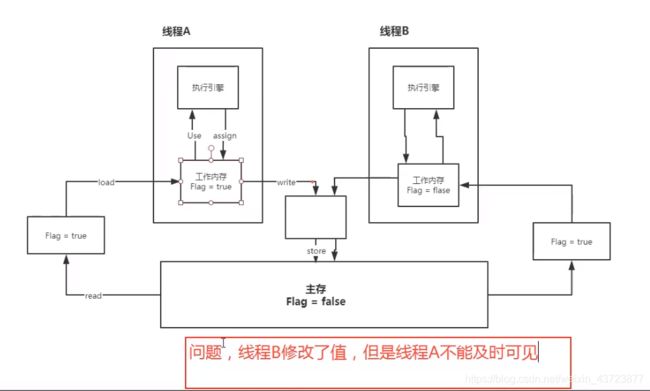
内存交互操作有8种,虚拟机实现必须保证每一个操作都是原子的,不可在分的(对于double和long类型的变量来说,load、store、read和write操作在某些平台上允许例外)
-
- lock (锁定):作用于主内存的变量,把一个变量标识为线程独占状态
- unlock (解锁):作用于主内存的变量,它把一个处于锁定状态的变量释放出来,释放后的变量才可以被其他线程锁定
- read (读取):作用于主内存变量,它把一个变量的值从主内存传输到线程的工作内存中,以便随后的load动作使用
- load (载入):作用于工作内存的变量,它把read操作从主存中变量放入工作内存中
- use (使用):作用于工作内存中的变量,它把工作内存中的变量传输给执行引擎,每当虚拟机遇到一个需要使用到变量的值,就会使用到这个指令
- assign (赋值):作用于工作内存中的变量,它把一个从执行引擎中接受到的值放入工作内存的变量副本中
- store (存储):作用于主内存中的变量,它把一个从工作内存中一个变量的值传送到主内存中,以便后续的write使用
- write (写入):作用于主内存中的变量,它把store操作从工作内存中得到的变量的值放入主内存的变量中
JMM对这八种指令的使用,制定了如下规则:
-
- 不允许read和load、store和write操作之一单独出现。即使用了read必须load,使用了store必须write
- 不允许线程丢弃他最近的assign操作,即工作变量的数据改变了之后,必须告知主存
- 不允许一个线程将没有assign的数据从工作内存同步回主内存
- 一个新的变量必须在主内存中诞生,不允许工作内存直接使用一个未被初始化的变量。就是怼变量实施use、store操作之前,必须经过assign和load操作
- 一个变量同一时间只有一个线程能对其进行lock。多次lock后,必须执行相同次数的unlock才能解锁
- 如果对一个变量进行lock操作,会清空所有工作内存中此变量的值,在执行引擎使用这个变量前,必须重新load或assign操作初始化变量的值
- 如果一个变量没有被lock,就不能对其进行unlock操作。也不能unlock一个被其他线程锁住的变量
- 对一个变量进行unlock操作之前,必须把此变量同步回主内存
问题:程序不知道主内存的值已经被修改过了
十七、Volatile
1、保证可见性
package com.radish.tvolatile;
import java.util.concurrent.TimeUnit;
/**
* @author: Radish
* @date: 2020-11-10 10:47
*/
public class JMMDemo {
// 不加volatile 程序就会死循环!
// 加volatile 可以保证可见性
private volatile static int num = 0;
public static void main(String[] args) {
new Thread(()->{ //线程1 对主内存的变化不知道的
while (num == 0){
}
}).start();
try {
TimeUnit.SECONDS.sleep(1);
} catch (InterruptedException e) {
e.printStackTrace();
}
num = 1;
System.out.println(num);
}
}
2、不保证原子性
原子性:不可分割
线程A在执行任务的时候,不能被打扰,也不能分割。要么同时成功,要么同时失败。
package com.radish.tvolatile;
/**
* @author: Radish
* @date: 2020-11-10 10:57
* 不保证原子性
*/
public class VDemo02 {
private volatile static int num = 0;
public static void add(){
num++;
}
public static void main(String[] args) {
for (int i = 1; i <= 20; i++) {
new Thread(()->{
for (int j = 0; j < 1000; j++) {
add();
}
}).start();
}
// 存活的线程数>2
while (Thread.activeCount() > 2) {
Thread.yield(); //礼让
}
System.out.println(Thread.currentThread().getName() + " " + num);
}
}
如果不加 lock 和 synchronized,怎么样保证原子性
package com.radish.tvolatile;
import java.util.concurrent.atomic.AtomicInteger;
/**
* @author: Radish
* @date: 2020-11-10 10:57
* 不保证原子性
*/
public class VDemo02 {
private volatile static AtomicInteger num = new AtomicInteger();
public static void add(){
// num++; //不是一个原子性操作
num.getAndIncrement(); // AtomicInteger+1 方法,CAS
}
public static void main(String[] args) {
for (int i = 1; i <= 20; i++) {
new Thread(()->{
for (int j = 0; j < 1000; j++) {
add();
}
}).start();
}
// 存活的线程数>2
while (Thread.activeCount() > 2) {
Thread.yield(); //礼让
}
System.out.println(Thread.currentThread().getName() + " " + num);
}
}
这些类的底层都直接和操作系统挂钩!在内存中修改值!Unsafe类是一个很特殊的存在!
指令重排
什么是 指令重排:你写的程序,计算机并不是按照你写的那样去执行
源代码–>编译器优化的重排–>指令并行也可能会重排–>内存系统也会重排–>执行
处理器在进行指令重排的时候,考虑:数据之间的依赖性!
int x = 1; //1
int y = 2; //2
x = x + 5; //3
y = x * x; //4
//我们所期望的:1234 但是可能执行的时候会变成2134 1234
//不可能是 4123!
可能造成影响的结果:a b x y 这四个值默认都是0
| 线程A | 线程B |
|---|---|
| x = a | y = b |
| b = 1 | a = 2 |
正常的结果:x=0, y=0;但是可能由于指令重排
| 线程A | 线程B |
|---|---|
| b = 1 | a = 2 |
| x = a | y = b |
指令重排导致的诡异结果:x=2,y=1
volatile可以避免指令重排:
内存屏障。CPU指令。作用:
1、保证特定的操作的执行顺序!
2、可以保证某些变量的内存可见性(利用这些特性volatile实现了可见性)

Volatile 是可以保证可见性,不能保证原子性,由于内存屏障,可以保证避免指令重排的现象产生!
十八、彻底玩转单例模式
饿汉式、DCL懒汉式,深究!
饿汉式
package com.radish.single;
/**
* @author: Radish
* @date: 2020-11-11 9:52
* 饿汉式单例
*/
public class Hungry {
//可能会浪费空间
private byte[] data1 = new byte[1024 * 1024];
private byte[] data2 = new byte[1024 * 1024];
private byte[] data3 = new byte[1024 * 1024];
private byte[] data4 = new byte[1024 * 1024];
private Hungry() {
}
private final static Hungry HUNGRY = new Hungry();
private final Hungry getInstance() {
return HUNGRY;
}
}
DCL懒汉式
package com.radish.single;
import java.lang.reflect.Constructor;
import java.lang.reflect.Field;
/**
* @author: Radish
* @date: 2020-11-11 10:00
* 懒汉式单例
*/
public class LazyMan {
private static boolean radish = false;
private LazyMan(){
synchronized (LazyMan.class) {
if(radish == false) {
radish = true;
}else {
throw new RuntimeException("不要试图使用反射破坏异常");
}
}
System.out.println(Thread.currentThread().getName()+"ok");
}
private volatile static LazyMan lazyMan;
// 双重检测模式的 懒汉式单例 DCL懒汉式
public static LazyMan getInstance(){
if(lazyMan == null) {
synchronized (LazyMan.class){
if (lazyMan==null) {
lazyMan = new LazyMan(); //不是一个原子性操作
}
}
}
return lazyMan;
}
//反射
public static void main(String[] args) throws Exception {
// LazyMan instance = LazyMan.getInstance();
Field radish = LazyMan.class.getDeclaredField("radish");
radish.setAccessible(true);
Constructor<LazyMan> declaredConstructor = LazyMan.class.getDeclaredConstructor(null);
declaredConstructor.setAccessible(true);
LazyMan instance = declaredConstructor.newInstance();
radish.set(instance, false);
LazyMan instance2 = declaredConstructor.newInstance();
System.out.println(instance);
System.out.println(instance2);
}
}
/**
* 1、分配内存空间
* 2、执行构造方法,初始化对象
* 3、把这个对象指向这个空间
*
* 123
* 132 A
* B // 此时lazyMan还没有完成构造
*/
静态内部类
package com.radish.single;
/**
* @author: Radish
* @date: 2020-11-11 10:18
* 静态内部类
*/
public class Holder {
private Holder(){
}
private static Holder getInstance(){
return InnerClass.HOLDER;
}
public static class InnerClass {
private static final Holder HOLDER = new Holder();
}
}
// Decompiled by Jad v1.5.8g. Copyright 2001 Pavel Kouznetsov.
// Jad home page: http://www.kpdus.com/jad.html
// Decompiler options: packimports(3)
// Source File Name: EnumSingle.java
package com.radish.single;
public final class EnumSingle extends Enum
{
public static EnumSingle[] values()
{
return (EnumSingle[])$VALUES.clone();
}
public static EnumSingle valueOf(String name)
{
return (EnumSingle)Enum.valueOf(com/radish/single/EnumSingle, name);
}
private EnumSingle(String s, int i)
{
super(s, i);
}
public EnumSingle getInstance()
{
return INSTANCE;
}
public static final EnumSingle INSTANCE;
private static final EnumSingle $VALUES[];
static
{
INSTANCE = new EnumSingle("INSTANCE", 0);
$VALUES = (new EnumSingle[] {
INSTANCE
});
}
}
十九、深入理解CAS
什么是CAS
大厂必须要深入研究底层!有所突破!修内功,操作系统,计算机网络原理
package com.radish.cas;
import java.util.concurrent.atomic.AtomicInteger;
/**
* @author: Radish
* @date: 2020-11-11 11:15
*/
public class CASDemo {
// CAS compareAndSet:比较并交换
public static void main(String[] args) {
AtomicInteger atomicInteger = new AtomicInteger(2020);
// 期望、更新
// public final boolean compareAndSet(int expect, int update)
// 如果我期望的值达到了,那么就更新,否则,就不更新,CAS 是CPU的并发原语!
System.out.println(atomicInteger.compareAndSet(2020, 2021));
System.out.println(atomicInteger.get());
System.out.println(atomicInteger.compareAndSet(2020, 2021));
System.out.println(atomicInteger.get());
}
}
Unsafe类
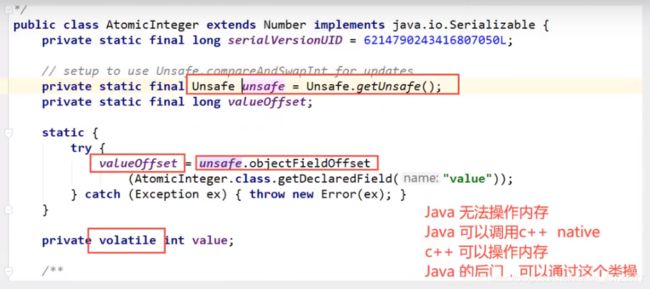


CAS:比较当前工作内存中的值和主内存中的值,如果这个值是期望的,那么则执行操作!如果不是就一直循环!
缺点:
1、循环会耗时
2、一次性只能保证一个共享变量的原子性
3、ABA问题
package com.radish.cas;
import java.util.concurrent.atomic.AtomicInteger;
/**
* @author: Radish
* @date: 2020-11-11 11:15
*/
public class CASDemo {
// CAS compareAndSet:比较并交换
public static void main(String[] args) {
AtomicInteger atomicInteger = new AtomicInteger(2020);
// 期望、更新
// public final boolean compareAndSet(int expect, int update)
// 如果我期望的值达到了,那么就更新,否则,就不更新,CAS 是CPU的并发原语!
// ============= 捣乱的线程 ==============
System.out.println(atomicInteger.compareAndSet(2020, 2021));
System.out.println(atomicInteger.get());
System.out.println(atomicInteger.compareAndSet(2021, 2020));
System.out.println(atomicInteger.get());
// ============= 期望的线程 ==============
System.out.println(atomicInteger.compareAndSet(2020, 6666));
System.out.println(atomicInteger.get());
}
}
二十、原子引用
解决ABA问题,引入原子引用!对应的思想:乐观锁
package com.radish.cas;
import java.util.concurrent.TimeUnit;
import java.util.concurrent.atomic.AtomicInteger;
import java.util.concurrent.atomic.AtomicStampedReference;
/**
* @author: Radish
* @date: 2020-11-11 11:15
*/
public class CASDemo {
// CAS compareAndSet:比较并交换
public static void main(String[] args) {
// AtomicInteger atomicInteger = new AtomicInteger(2020);
AtomicStampedReference<Integer> integerAtomicStampedReference = new AtomicStampedReference<>(1, 1);
new Thread(()->{
int stamp = integerAtomicStampedReference.getStamp();
System.out.println("a1=>"+stamp);
try {
TimeUnit.SECONDS.sleep(2);
} catch (InterruptedException e) {
e.printStackTrace();
}
System.out.println(integerAtomicStampedReference.compareAndSet(1, 2,
integerAtomicStampedReference.getStamp(), integerAtomicStampedReference.getStamp() + 1));
System.out.println("a2=>"+integerAtomicStampedReference.getStamp());
System.out.println(integerAtomicStampedReference.compareAndSet(2, 1,
integerAtomicStampedReference.getStamp(), integerAtomicStampedReference.getStamp() + 1));
System.out.println("a3=>"+integerAtomicStampedReference.getStamp());
},"a").start();
new Thread(()->{
int stamp = integerAtomicStampedReference.getStamp();
System.out.println("b1=>"+stamp);
try {
TimeUnit.SECONDS.sleep(2);
} catch (InterruptedException e) {
e.printStackTrace();
}
System.out.println(integerAtomicStampedReference.compareAndSet(1, 6,
integerAtomicStampedReference.getStamp(), integerAtomicStampedReference.getStamp() + 1));
System.out.println("b1=>"+integerAtomicStampedReference.getStamp());
},"b").start();
}
}
注意:
Integer使用了对象缓存机制,默认范围是-128~127,推荐使用静态工厂方法valueOf获取对象实例,而不是new,因为valueOf使用缓存,而new一定会创建新的对象分配新的内存空间
二十一、各种锁的理解
21.1 公平锁
公平锁:非常公平,不能够插队,必须先来后到!
非公平锁:非常不公平,可以插队(默认都是非公平)
//默认非公平锁
public ReentrantLock() {
sync = new NonfairSync();
}
public ReentrantLock(boolean fair) {
sync = fair ? new FairSync() : new NonfairSync();
}
21.2 可重入锁
Synchonized
package com.radish.lock;
/**
* @author: Radish
* @date: 2020-11-12 11:02
* Synchronized
*/
public class Demo01 {
public static void main(String[] args) {
Phone phone = new Phone();
new Thread(()->{
phone.sms();
},"A").start();
new Thread(()->{
phone.sms();
},"B").start();
}
static class Phone{
public synchronized void sms(){
System.out.println(Thread.currentThread().getName()+"sms");
call(); //这里也有锁
}
public synchronized void call() {
System.out.println(Thread.currentThread().getName()+"call");
}
}
}
Lock 版
package com.radish.lock;
import java.util.concurrent.locks.Lock;
import java.util.concurrent.locks.ReentrantLock;
/**
* @author: Radish
* @date: 2020-11-12 11:09
*/
public class Demo02 {
public static void main(String[] args) {
Phone2 phone = new Phone2();
new Thread(()->{
phone.sms();
},"A").start();
new Thread(()->{
phone.sms();
},"B").start();
}
static class Phone2{
Lock lock = new ReentrantLock();
public void sms(){
lock.lock(); // 细节问题:lock.lock(); lock.unlock(); //lock 锁必须配对,否则就会死在里面
lock.lock();
try {
System.out.println(Thread.currentThread().getName() + "sms");
call(); // 这里也有锁
} catch (Exception e){
e.printStackTrace();
} finally {
lock.unlock();
lock.unlock();
}
}
public void call() {
lock.lock();
try {
System.out.println(Thread.currentThread().getName()+"call");
} catch (Exception e){
e.printStackTrace();
} finally {
lock.unlock();
}
}
}
}
21.3 自旋锁
package com.radish.lock;
import java.util.concurrent.atomic.AtomicReference;
/**
* @author: Radish
* @date: 2020-11-12 11:20
*/
public class SpinlockDemo {
// int 0
// Thread null
AtomicReference<Thread> atomicReference = new AtomicReference<>();
// 加锁
public void myLock() {
Thread thread = Thread.currentThread();
System.out.println(Thread.currentThread().getName() + "==> mylock");
// 自旋锁
while (!atomicReference.compareAndSet(null, thread)) {
}
}
// 解锁
public void myUnLock() {
Thread thread = Thread.currentThread();
System.out.println(Thread.currentThread().getName() + "==> myUnlock");
atomicReference.compareAndSet(thread, null);
}
}
测试
package com.radish.lock;
import java.util.concurrent.TimeUnit;
/**
* @author: Radish
* @date: 2020-11-12 11:28
*/
public class TestSpinLock {
public static void main(String[] args) throws InterruptedException {
// 底层使用的自旋锁CAS
SpinlockDemo lock = new SpinlockDemo();
new Thread(()->{
lock.myLock();
try {
TimeUnit.SECONDS.sleep(5);
} catch (Exception e){
e.printStackTrace();
} finally {
lock.myUnLock();
}
},"T1").start();
TimeUnit.SECONDS.sleep(1);
new Thread(()->{
lock.myLock();
try {
TimeUnit.SECONDS.sleep(1);
} catch (Exception e){
e.printStackTrace();
} finally {
lock.myUnLock();
}
},"T2").start();
}
}
21.4 死锁
package com.radish.lock;
import java.util.concurrent.TimeUnit;
/**
* @author: Radish
* @date: 2020-11-12 11:44
*/
public class DeadLockDemo {
public static void main(String[] args) {
String lockA = "lockA";
String lockB = "lockB";
new Thread(new MyThread(lockA, lockB),"T1").start();
new Thread(new MyThread(lockB, lockA),"T2").start();
}
}
class MyThread implements Runnable {
private String lockA;
private String lockB;
public MyThread(String lockA, String lockB) {
this.lockA = lockA;
this.lockB = lockB;
}
@Override
public void run() {
synchronized (lockA) {
System.out.println(Thread.currentThread().getName() + "lock:" + lockA+ "=>get" + lockB);
try {
TimeUnit.SECONDS.sleep(2);
} catch (InterruptedException e) {
e.printStackTrace();
}
synchronized (lockB) {
System.out.println(Thread.currentThread().getName() + "lock:" + lockB+ "=>get" + lockA);
}
}
}
}
package com.radish.lock;
import java.util.concurrent.TimeUnit;
/**
* @author: Radish
* @date: 2020-11-12 11:44
*/
public class DeadLockDemo {
public static void main(String[] args) {
String lockA = "lockA";
String lockB = "lockB";
new Thread(new MyThread(lockA, lockB),"T1").start();
new Thread(new MyThread(lockB, lockA),"T2").start();
}
}
class MyThread implements Runnable {
private String lockA;
private String lockB;
public MyThread(String lockA, String lockB) {
this.lockA = lockA;
this.lockB = lockB;
}
@Override
public void run() {
synchronized (lockA) {
System.out.println(Thread.currentThread().getName() + "lock:" + lockA+ "=>get" + lockB);
try {
TimeUnit.SECONDS.sleep(2);
} catch (InterruptedException e) {
e.printStackTrace();
}
synchronized (lockB) {
System.out.println(Thread.currentThread().getName() + "lock:" + lockB+ "=>get" + lockA);
}
}
}
}
解决问题
1、使用jps -l定位进程号
1、日志
2、堆栈








